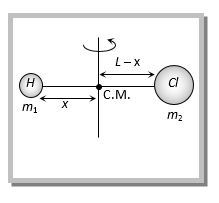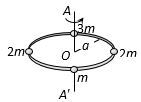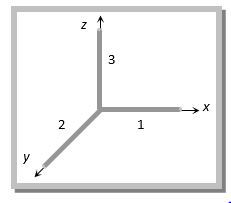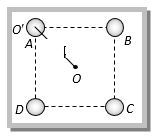12th Grade > Physics
ROTATION THE BASIC DEFINITION MCQs
Total Questions : 30
| Page 3 of 3 pages
Answer: Option C. -> a
:
C
Since the circular frame is massless so we will consider moment of inertia of four masses only.
I=ma2+2ma2+3ma2+2ma2=8ma2 .....(i)
Now from the definition of radius of gyration I=8mk2 .....(ii)
comparing (i) and (ii) radius of gyration k = a.
:
C
Since the circular frame is massless so we will consider moment of inertia of four masses only.
I=ma2+2ma2+3ma2+2ma2=8ma2 .....(i)
Now from the definition of radius of gyration I=8mk2 .....(ii)
comparing (i) and (ii) radius of gyration k = a.
Answer: Option B. -> 1.61×10−47kg.m2
:
B
If r1 and r2 are the respective distances of particles m1 and m2 from the centre of mass then
m1r1=m2r2⇒1×x=35.5×(L−x)⇒x=35.5(1−x)
⇒x=0.973oA and L−x=0.027oA
Moment of inertia of the system about centre of mass I=m2x+m2(L−x)2
I=1amu×(0.973oA)2+35.5amu×(0.027oA)2
Substituting 1 a.m.u. =1.67×10−27kg and 1oA=10−10m
I=1.62×10−47kgm2

:
B
If r1 and r2 are the respective distances of particles m1 and m2 from the centre of mass then
m1r1=m2r2⇒1×x=35.5×(L−x)⇒x=35.5(1−x)
⇒x=0.973oA and L−x=0.027oA
Moment of inertia of the system about centre of mass I=m2x+m2(L−x)2
I=1amu×(0.973oA)2+35.5amu×(0.027oA)2
Substituting 1 a.m.u. =1.67×10−27kg and 1oA=10−10m
I=1.62×10−47kgm2

Answer: Option B. -> Ml212
:
B
Moment of inertia of system about an axes which is perpendicular to plane of rods and passing through the common centre of rods Iz=Ml212+Ml212=Ml26
Again from perpendicular axes theorem I2=IB1+IB2=2IB1=2IB2=Ml26 [As IB1=IB2]
∴IB1=IB2=Ml212.
:
B
Moment of inertia of system about an axes which is perpendicular to plane of rods and passing through the common centre of rods Iz=Ml212+Ml212=Ml26
Again from perpendicular axes theorem I2=IB1+IB2=2IB1=2IB2=Ml26 [As IB1=IB2]
∴IB1=IB2=Ml212.
Answer: Option C. -> 60l
:
C
Moment of inertia of rod AB about its centre and perpendicular to the length =ml212=l∴ml2=12l
Now moment of inertia of the rod about the axis which is passing through O and perpendicular to the plane of hexagon lrod=ml212+mx2 [From the theorem of parallel axes]
=ml212+m(√32l)2=5ml26
Now the moment of inertia of system lsystem=6×Irod=6×5ml26=5ml2
lsystem=5(12l)=60l [As ml2=12l]

:
C
Moment of inertia of rod AB about its centre and perpendicular to the length =ml212=l∴ml2=12l
Now moment of inertia of the rod about the axis which is passing through O and perpendicular to the plane of hexagon lrod=ml212+mx2 [From the theorem of parallel axes]
=ml212+m(√32l)2=5ml26
Now the moment of inertia of system lsystem=6×Irod=6×5ml26=5ml2
lsystem=5(12l)=60l [As ml2=12l]

Answer: Option D. -> 2b+6ct
:
D
Angular acceleration α=d2θdt2=d2dt2(at+bt2+ct3)=2b+6ct
:
D
Angular acceleration α=d2θdt2=d2dt2(at+bt2+ct3)=2b+6ct
Question 29. Let 'l' be the moment of inertia of an uniform square plate about an axis AB that passes through its centre and is parallel to two of its sides. CD is a line in the plane of the plate that passes through the centre of the plate and makes an angle θ with AB. The moment of inertia of the plate about the axis CD is then equal to
Answer: Option A. -> I
:
A
Let Izis the moment of inertia of square plate about the axis which is passing through the centreand perpendicular to the plane.
IZ=IAB+IA′B′=ICD+IC′D′ [By the theorem of perpendicular axis]
IZ=2IAB=2IA′B′=2ICD=2IC′D′
[As AB, A' B' and CD, C' D' are symmetric axis]
Hence ICD=IAB=I

:
A
Let Izis the moment of inertia of square plate about the axis which is passing through the centreand perpendicular to the plane.
IZ=IAB+IA′B′=ICD+IC′D′ [By the theorem of perpendicular axis]
IZ=2IAB=2IA′B′=2ICD=2IC′D′
[As AB, A' B' and CD, C' D' are symmetric axis]
Hence ICD=IAB=I

Answer: Option D. -> 1980degrees/sec2
:
D
Angular acceleration (a) = rate of change of angular speed
=2π(n2−n1)t=2π(4500−120060)10=2π33006010×3602πdegreesec2=1980degree/sec2.
:
D
Angular acceleration (a) = rate of change of angular speed
=2π(n2−n1)t=2π(4500−120060)10=2π33006010×3602πdegreesec2=1980degree/sec2.






















